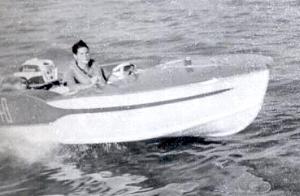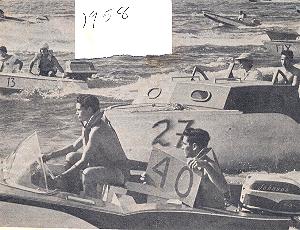The Red Dart
Continued...
Several years before, my father had built a small dinghy. It was an 8-foot boat that was used for ship to shore duties on a Cruiser that he had built many years before. The cruiser was sold, but we kept the dinghy. Since we didn't have a place to keep it, it was loaned to a friend. Later this friend would let us use his garage to build the L-Dorado.
The dinghy was stored in another marina in a river not far from home. I started to use the dinghy, I would go in on Saturday afternoons and row for several hours to kill time and get some excersise. After several weeks of this, my father and I picked up the dingy at the marina and transported it to the Commodore Yacht Club where they cleared a spot under the shelters where I kept it. On the weekend and under a watchful eye of my parents, I would row in the waterfront and spend time enjoying and learning about the sea.
After several months of this, my father started to wonder if he could build a boat and keep it in the marina. Would they have a place for him to store it? He asked the operators and they assured him that when the time came a place would be found for it. That is when the project of building a boat began. My father started searching in several boating magazines and came across an ad about Glen-L Marine. He ordered the catalog and when it arrived he found a wealth of great projects. However, the one that he liked was the one featured in the ad, L-Dorado. It was the Cadillac of runabouts. It had fins, and it was only 13 feet long. It was wide and three people could sit in front. A light 35 Hp outboard motor could propel it up to 30 miles per hour. It was easy to build and easy to maintain. He said, "this is what I want!" It was love at first sight!
He wrote to Glen-L Marine and asked if they could ship the plans and Frame kit for L-Dorado to Havana, Cuba. Several days later, we received communication with a quote; Glen-L had an export agent that could ship kits to other countries. With that in mind, my father went to the bank and opened an export letter for the amount that was requested in the quote, and we waited for the kit and plans to come in.
About a month later, the shipping agent in Cuba said that he had received the kit and it was in their warehouse. My father went to downtown Havana and paid the duties on these items and took the goods with him. The kit consisted of all of the frames and bulkheads, transom, stem and breasthook plus the plans.
His friend, Mr. Jose Garcia, had an old garage that he built several years before. It was a rustic place with a corrugated zinc roof to keep the weather off. My father asked if we could use the garage to build the boat. He estimated the time of construction for about one month if we worked hard at it. Mr. Garcia said that he did not see any problem. He was also a boat builder, so he wanted to help with the project. Afterward, Mr. Garcia built another L-Dorado using the same plans.
The kit pieces were placed upside down on a wood form that ran the length of the boat. The angle for the stern was measured. The distance from each other was measured and adjusted. The keel was laid in the middle and local wood was purchased for the project.
I remember installing brass screws and hammering thousands of rib nails in the plywood. My father did all the measuring and detailed work. I just provided manpower after school. It was hot working under the zinc roof, but little by little; the hull started to take shape. The last part to form was the bow planking. My father and his friend used a combination of hot water and TLC to fit and install the side planks.
Then the hull was turned upright and the top part was installed. I remember installing the hardware. Since I was the skinny guy of the group. I was chosen as the only one that could get under the dashboard and install the hardware for pulleys and cables to steer the motor. I also installed the hardware for the windshield and the control cables for the engine.
In Cuba there was no auto trailer industry. The only way we could have a trailer would be to order it from the USA and ship it to Havana or choose a homebrew. We did the latter. My father bought an axle with wheels and spring leaves. From stock steel channels they built a square that was placed on top of the long angle, measuring about 15 feet in length. At one end of the channel a trailer hitch was installed. We didn't have an arc welder; so instead, we used bolts to fasten all the metal together. The wheels were placed under the trailer and the boat was placed on top. It fit perfectly.
My father went to the local Johnson dealer and purchased a brand-new 35 HP 1957 Johnson outboard motor. In those days Johnson shipped the engine in a crate. We broke the wooden crate and installed it on the stern mounts. These were the days of simplicity! Two screws with handles and a back bracket held the engine to the hull. Then the gas intake on the side had quick disconnect with a clip. The engine had a short tiller for emergencies or in case the steering cables broke.

The boat was christened "Red Dart"1 since the sidewalls were all painted in the same color scheme as the Glen-L drawings but with red as the primary color to match the engine. The varnished deck ran back to the tails. In the middle of the foredeck we installed one cleat. The deck was varnished by hand which lasted long after we left Cuba.
We took the boat to the marina and placed in the water. It was a calm day. We had to run the engine for several hours to break it in. Then it was OK to run it at full bore.
Within a couple of days, we noticed that the paint job under the hull was starting to peel off. My father then decided to keep the integrity of the hull but to add a little more weight to the hull by running two coats of fiberglass on the bottom, so we had to disassemble the engine and gas tank and turn the hull upside down again. We hand painted the first coat of resin then installed the fiberglass material and another coat of resin. The second coat, we added white coloring to the resin, to match the boat's color.

The workmanship and the beautiful curved tails was usually the talk of the marina. "Look, look, it looks like a Cadillac!", the members would say. Needless to say, my Father's friend always commented about how beautiful the boat looked. My father was so proud of his boat and especially when I entered a Regatta one Sunday morning. We won 2nd Place and a trophy. The Commodore Yacht Club was proud of us being members, in fact a small ceremony was performed later by the Club's Commodore to officially certify the trophy that we brought with us.
In 1959, Cuba changed government. The Commodore Yacht Club continued to have new visitors. In May or June of that year, I remember being told that Mr. Errol Flynn was a guest of the Commodore Hotel. One day, I spotted him walking on the beach with a fairly young girl that could have been his daughter. He was a far cry from the dashing actor of "The Adventures Robing Hood" 1938, the swashbuckling version of the legendary story. He said to me, "would it be possible to take a ride in your boat". Sure, I agreed and took him for a quick ride around the coast. That was the last time I saw him and his girl friend. Later while I was in the US Army and stationed in Fort Gordon, Ga., I learned that he passed away. Alcohol and women took a toll on this famous actor that looked with haughty insolence during the decades of the 30's and 40's.
Because of the political situation and that my family and I didn't agree the way things were going in Cuba. In 1961 we left the country, leaving behind the Red Dart and several other things. I can't remember if it was left at the Club or if my father brought it back home. I know for sure that someone else must have enjoyed this simple but crafty little boat that made us so proud for so many years. Now that it's going to be my 60th birthday, I only hope that you enjoy this story that's been in my memory for so long.
Thanks and God Bless America!
Note: 1 This information was provided by my brother, Mr. Carlos Urbizu. Sometimes he amazes me with his memory, since he was only 8 or 9 years old when the boat was built.